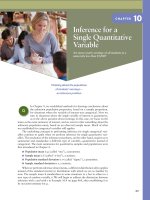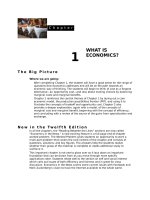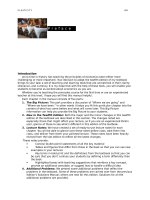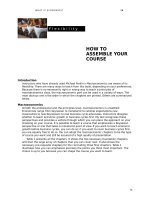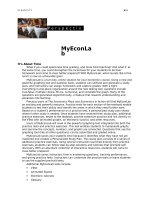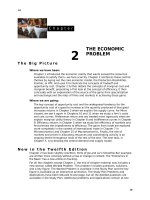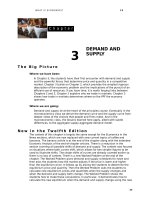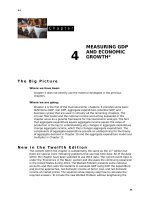The big picture marcoeconomics 12e parkin chapter 04
Bạn đang xem bản rút gọn của tài liệu. Xem và tải ngay bản đầy đủ của tài liệu tại đây (277.84 KB, 16 trang )
34
C h a p t e r
4
MEASURING GDP
AND ECONOMIC
GROWTH**
The Big Picture
Where we have been:
Chapter 4 does not directly use the material developed in the previous
chapters.
Where we are going:
Chapter 4 is the first of the macroeconomic chapters. It provides some basic
definitions (GDP, real GDP, aggregate expenditure, potential GDP, and
business cycles) that are used in virtually all the remaining chapters. The
circular flow model and the national income accounting explained in this
chapter serve as a general framework for macroeconomic analysis. The fact
that aggregate expenditure equals aggregate income equals the value of
production is the key to understanding why changes in aggregate expenditure
change aggregate income, which then changes aggregate expenditure. The
components of aggregate expenditure provide an underpinning for the theory
of aggregate demand in Chapter 10 and the aggregate expenditure model and
multiplier in Chapter 11.
N e w i n t h e Tw e l f t h E d i t i o n
The content within the chapter is substantially the same as the 11th edition but
there are special icons indicating problems that use real-time data. All of the data
within the chapter have been updated to use 2014 data. The current event topic is
under the ‘Economics in the News’ section and discusses the continuing expansion
in the United States during 2014. The Worked Problem presents some national
accounts and then asks the students to calculate GDP using both the expenditure
and income approaches, net domestic income at factor cost, and net domestic
income at market prices. The solutions show step-by-step how to calculate the
required answers. To include the new Worked Problem without lengthening the
34
35
chapter, some problems have been removed from the Study Plan Problem and
Applications. These problems are in the MyEconLab and are called Extra Problems.
35
Lecture Notes
Measuring GDP and Economic Growth
GDP is a measure of total production and total income.
Real GDP measures production of goods and services.
GDP can be used to make comparisons over time and across countries.
I. Gross Domestic Product
GDP or gross domestic product is the market value of all the final goods and services
produced within a country in a given time period.
How do you add apples and oranges? You can pick any goods you like but I think it is
helpful to show GDP as an equation early on. You can start with real goods and then
generalize to “n goods”:
GDP = PAQA + POQO + …
GDP = P1Q1 + P2Q2 + P3Q3 + … + PNQN
GDP = ∑ PiQi
You may find it useful to add slang while you discuss GDP, “GDP is the dollar value of all
‘stuff’ made over one year.” Be sure to repeat the definition as you move through all the
chapters rather than assuming the your students always remember what is in GDP and
how it is measured. A solid understanding of GDP is crucial for other material to make
sense.
The items in GDP are valued at their market values, that is, at their prices. So if
100,000,000 slices of pizza are sold for $3 each, slices of pizza contribute
$300,000,000 to GDP. Using market values means that the total value of output,
that is, GDP will be in the dollars (or whatever the country’s currency unit might
be).
A final good is an item that is bought by its final user. It contrasts with an
intermediate good, which is an item that is produced by one firm, bought by
another firm, and used as a component of a final good or service.
To avoid double counting, GDP includes only final goods and services (no
intermediate goods and services are directly counted).
Only the goods and services produced within a country are counted. A Honda
produced in North Carolina is counted in U.S. GDP.
GDP is measured over a period of time, typically a quarter of a year or a year.
Gross Domestic Product. The main challenge in teaching this topic is generating
interest in it. Many teachers are bored by it and not surprisingly, they bore their students.
If you are one of the many who lean toward boredom, start by recalling just how vital it is
that we measure the value of production with reasonable accuracy. Working through issues
with GDP is vital since it serves as the basis of measurement of the standard of living,
economic welfare, and making international comparisons.
Final goods versus intermediate goods. The distinction between final and intermediate
goods is one of the key points in this first section. Use some standard examples to make
the key point—tires and autos, chips and computers, and so on. Also, if you want to spend
a bit of time on this topic, tell your students about the Bureau of Economic Analysis (BEA)
revision in the treatment of business spending on software. The BEA began a major
revision in 1998 and published the first revisions to reclassify software from intermediate
to final good status in 1999. When the 1996 GDP was recalculated to include software as a
final good, GDP increased by $115 billion, or 1.5 percent.
MEASURING GDP AND ECONOMIC GROWTH
GDP and the Circular Flow of Expenditure and Income
The circular flow illustrates the equality of income, expenditure, and the value of
production. The circular flow diagram shows the transactions among four economic
agents—households, firms, governments, and the rest of the world—in two
aggregate markets—goods markets and factor markets.
In the goods market, households, firms, governments, and foreigners buy goods and
services. For analytical purposes, we can categorize spending by these four agents
in the calculation of GDP:
The total payment for goods and services by households in the goods markets is
consumption expenditure , C.
The purchases of new plants, equipment, and buildings and the additions to
inventories are investment, I.
Governments buy goods and services, called government expenditure or G,
from firms.
Firms sell goods and services to the rest of the world, exports or X, and buy
goods and services from the rest of the world, imports or M. Exports minus
imports are called net exports, X M.
Government transfer payments, such as Social Security payments, are not part of
government expenditures because government expenditures include only funds used by
the government to buy goods and services. Transfer payments are not buying a good or
service for the government and so are not included in government expenditures.
In factor markets households receive income from selling the services of resources to
firms. The total income received is aggregate income. It includes wages paid to
workers, interest for the use of capital, rent for the use of land and natural resources,
and profits paid to entrepreneurs; retained profits can be viewed as part of
household income, lent back to firms.
The Circular Flow Model. Start with a simpler picture than Figure 4.1—just households
and firms, and just income and consumption. Explain that you are starting from the basics,
in which all goods and services produced are sold to consumers. Explain that even beyond
the assumption that all goods and services are consumption goods and services, we’re
simplifying things in the picture but are not omitting anything that leads us into a
misleading conclusion. For instance the picture envisages all the income being paid to
households. Nothing is lost and clarity is gained by this device. Emphasize that the blue
flows are incomes and the red flows are expenditures on final goods and services. Clearly
in this simplest case aggregate income equals aggregate expenditure. Then add
investment. It is still the case that aggregate expenditure (which is now C + I) equals
aggregate income. Next add the government and the flow of government expenditure.
Finally add the rest of the world and the flow of net exports. In both cases you can continue
to make the crucial point at aggregate expenditure equals aggregate income.
GDP Equals Expenditure Equals Income
Aggregate expenditure equals C + I + G + (X M) . Aggregate expenditure equals
GDP because all the goods and services that are produced are sold to households,
firms, governments, or foreigners. (Goods and services not sold are included in
investment as inventories and hence are “sold” to the producing firm.)
Because firms pay out as income everything they receive as revenue from selling
goods and services, aggregate income equals aggregate expenditure equals GDP.
Why “Domestic” and Why “Gross”?
Depreciation is the decrease in the stock of capital that results from wear and tear
and obsolescence. The total amount spent on purchases of new capital and on
35
36
CHAPTER 4
replacing depreciated capital is called gross investment. The amount by which
the stock of capital increases is net investment. Net investment = Gross
investment Depreciation.
The “Gross” in gross domestic product reflects the fact that the investment in GDP is
gross investment and so part of it goes to replace depreciating capital. Net domestic
product subtracts depreciation from GDP.
MEASURING GDP AND ECONOMIC GROWTH
II. Measuring U.S. GDP
Most of the income data used by the BEA to measure GDP come from the IRS. Expenditure
data come from a variety of sources.
The Expenditure Approach
The expenditure approach measures GDP as the sum of consumption expenditure, C,
investment, I, government expenditure on goods and services, G, and net exports of
goods and services, (X M). So GDP = C + I + G + (X M) or, in 2014 and in billions
of dollars, $11,729 + $2,714 + $3,139 + $538 = $17,044.
The Income Approach
The income approach measures GDP as the sum of compensation of employees, net
interest, rental income, corporate profits, and proprietors’ income. This sum equals
net domestic income at factor costs. To obtain GDP, indirect taxes (which are taxes
paid by consumers when they buy goods and services) minus subsidies plus
depreciation are included. Finally any discrepancy between the expenditure
approach and income approach is included in the income approach as “statistical
discrepancy.”
Measuring U.S. GDP, the low cost of economic data. You might like to tell your
students that measuring real GDP is actually very cheap. The BEA (in the Department of
Commerce) employs fewer than 500 economists, accountants, statisticians, and IT
specialists at an annual cost of less that $70 million. It costs each American less than
0.25¢ (a quarter of a cent) to measure the value of the nation’s production. For some
further perspective, the National Oceanic and Atmospheric Administration (also in the
Department of Commerce), whose mission is to “describe and predict changes in the
Earth’s environment, and conserve and manage wisely the nation’s coastal and marine
resources so as to ensure sustainable economic opportunities,” employs more than 11,000
scientists and support personnel at an annual cost of $3.2 billion!
Creative accounting and GDP measurement. In recent years, the first estimates of
GDP, which are based on companies’ reported profits, have been revised downward when
data on company profits as reported to the IRS became available. Enron-style accounting
has contaminated the initial estimates of GDP but not the final estimates. You can make a
nice point with one example of creative accounting. For some years, in its reports to stock
holders AOL recorded its advertising expenditure as investment and amortized it over a
number of years. First, you can explain that the correct treatment of this item is as an
expenditure on intermediate goods and services by AOL and as a charge against AOL
profit. The expenditure on AOL services is the value of AOL’s production. And AOL’s
expenditure on advertising is part of the value of the production of the advertising
agencies used by AOL. You can go on to explain that AOL accounting practice would
misleadingly swell GDP by causing some double counting. On the expenditure approach,
AOL’s advertising expenditure shows up as investment in the national accounts. On the
income approach, because the expenditure is not a cost, it swells profit, so AOL’s corporate
profit increases by the same amount as its “investment.” If AOL filed its income tax return
in this same way, the national income accounts wouldn’t get corrected. But if, when AOL
files its tax returns, it calls its advertising a cost and lowers its profits by that amount, the
BEA picks up these numbers from the IRS and the national accounts are adjusted
appropriately.
Nominal GDP and Real GDP
The market value of production and hence GDP can increase either because the
production of goods and services are higher or because the prices of goods and
services are higher.
37
38
CHAPTER 4
Real GDP allows the quantities of production to be compared across time. Real GDP
is the value of final goods and services produced in a given year when valued at the
prices of a reference base year.
Nominal GDP is the value of the final goods and services produced in a given year
valued at the prices that prevailed in that same year.
MEASURING GDP AND ECONOMIC GROWTH
Calculating Real GDP
Traditionally, real GDP is calculated
using prices of the reference base
year (the year in which real
GDP=nominal GDP).
The tables to the right show this
method of calculating real GDP for
an economy that produces only
books and coffee. If 2014 is the
reference base year, nominal GDP
in 2014 in the top table equals real
GDP in 2014 Real GDP in 2014 is
$3,000.
The second table shows the
calculation for nominal GDP in
2015.
Real GDP in 2015 is in the bottom
table. It values 2015 production
using the prices from the reference
base year, 2014. Real GDP in 2015
is $4,250.
Data for 2014
Item
Quanti
ty
Pric
e
Books
40
$25
Coffee
1,000
$2
Nominal
GDP
Market
Value
$1,000
$2,000
$3,000
Data for 2015
Item
Quanti
ty
Pric
e
Books
50
$30
$1,500
Coffee
1,500
$3
$4,500
Nominal
GDP
Market
Value
$6,000
2015 Quantities and 2014 Prices
Item
Quanti
ty
Pric
e
Market
Value
Books
50
$25
$1,250
Coffee
1500
$2
$3,000
You may want to mention the GDP deflator at this point even though coverage of it is in
next chapter. Stress the separation of the “quantity effect,” measured by real GDP, and the
“price effect,” measured by the price level. Real GDP will be used to compute the economic
growth rate while the price level will be used to compute the inflation rate.
REQUIRES MATHEMATICAL NOTE: Chained-Dollar Real GDP
The top table to the right has data
GDP Data for 2014
for 2014 for an economy that
Item
Quanti Pric Market
produces only books and coffee. In
ty
e
Value
2014, nominal GDP is $3,000. The
Books
40
$25
$1,000
second table to the right has the
same data for 2015. (These tables
Coffee
1,000
$2
$2,000
are the same as used above to
Nominal
$3,000
calculate real GDP using the
GDP
standard method.) In 2015,
nominal GDP is $6,000.
GDP Data for 2015
Nominal GDP has doubled but how
Item
Quanti Pric Market
much has real GDP changed
ty
e
Value
between these years?
Books
50
$30
$1,500
To determine how real GDP
changes, suppose that 2014 is the
Coffee
1,500
$3
$4,500
base year. Then we need to determine the growth rate between 2014 and 2015 by
39
40
CHAPTER 4
calculating the value of production in both years using 2014 prices and also
calculating it in both years using 2015 prices.
Using 2014 prices, the value of production increases from $3,000 (the first table) to
$4,250 (the third table). Using 2014 prices, the value of production has grown by
100 ($4,250 $3,000)/$3,000 = 41.7 percent.
Using 2015 prices, real GDP increases from $4,200 (the fourth table) to $6,000 (the
second table). Using 2015 prices, the value of production has grown by
100 ($6,000 $4,200)/$4,200 = 42.9 percent.
The average growth rate is equal 2015 Quantities and 2014 Prices
to (41.7 percent + 42.9
Item
Quantit Pric
percent)/2 = 42.3 percent. So real
y
e
GDP between these years has
Books
50
$25
grown by 42.3 percent. If 2014 is
Coffee
1500
$2
the base year, real GDP in 2011 is
Value of
$3,000 1.423 = $4,269.
production
Similar calculations are made for
(2010
each pair of adjacent years from
dollars)
the reference base year onwards.
This procedure chains real GDP
2014 Quantities and 2015 Prices
back to the reference base year.
Item
Quantit Pric
y
e
III. The Uses and Limitations of
Market
Value
$1,250
$3,000
$4,250
Market
Value
Real GDP
Books
40
$30
$1,200
The Standard of Living Over Time
Coffee
1,000
$3
$3,000
One measure of the standard of
Value of
$4,200
living over time is real GDP per
production
person, or real GDP divided by the population. Real GDP per person tells us the value
of goods and services that the average person can enjoy.
The value of real GDP when all the economy’s labor, capital, land, and
entrepreneurial ability are fully employed is called potential GDP. Potential GDP
grows at a steady pace because the quantities of the factors of production and their
productivity grow at a steady pace.
The growth rate of real GDP slowed in the productivity growth slowdown after 1970.
This slowdown created a Lucas wedge. A Lucas wedge is the dollar value of the
accumulated gap between what real GDP per person would have been if the growth
rate had persisted and what real GDP per person actually turned out to be.
The Importance of the Lucas Wedge. It is usually straightforward to interest students
in the business cycle. But it is perhaps a bit more difficult to motivate interest in economic
growth and the Lucas wedge. Yet economic growth and the Lucas wedge should be of
immense importance to young students because they help determine the long-run living
standard of their lives. One way to make this point clear is to ask the students whether the
difference between, say, 3 percent annual growth in income versus 4 percent annual
growth is important. This difference probably does not sound important. But, suppose that
the initial income was $35,000. After 10 years with 3 percent growth, the income would be
$47,037 and with 4 percent growth the income would be $51,809. This difference of about
$4,500 might not seem like much. But point out to the students that this difference is for
only ten years and that the annual difference will continue to enlarge: After 30 years with 3
percent growth, the income would be $84,954 and with 4 percent growth the income would
be $113,519, a one year difference of about $40,000. And, over a 30-year working career,
the total differences in income, which is the analog to the Lucas wedge, is approximately
$420,000. Over a 40-year working career, the Lucas wedge difference is over $1,000,000!
Viewed from this perspective, the seemingly slight 1 percentage point difference in growth
MEASURING GDP AND ECONOMIC GROWTH
rates makes for an incredibly major difference in incomes, which should easily capture
your students’ attention.
Fluctuations in the pace of expansion of real GDP is denoted the business cycle,
periodic but irregular increases and decreases in the total production and other
measures of economic activity. Each cycle is categorized by: trough, expansion,
peak, recession.
The Business Cycle. Students generally are interested in the topic of business cycles,
particularly if the economy happens to be in a recession when this chapter is covered.
Often it is very difficult to tell the future path of the economy. Stress to the students that it
is not stupidity on the part of economists that prevents us from knowing where the
economy is heading. Rather it is the fact that forecasting is difficult for at least two
reasons. First, different sectors of the economy frequently send different signals. For
instance, retail sales may be down, signaling a start to a recession, but housing starts may
be up, indicating that an expansion will continue for a while. Second, the data that must be
used always are at least a bit out-of-date. For example, the preliminary estimate of GDP is
not made until approximately six weeks after the end of the quarter, and the final revision
of GDP doesn’t appear until years later. Although economists’ forecasts are much better
than those of others, forecasting GDP with complete accuracy is unlikely. Conclude by
mentioning that this fact is important in later chapters when we discuss implementation of
counter-cyclical policies.
The Business Cycle, Part 2: The business cycle and its dating are interesting to
students, especially when the economy is in or near a recession. If you have the capacity to
show or assign Web pages, look at the NBER Business Cycle Dating Committee’s page at
/>You might like to look at the dating of the cycle in other countries. This dating is done by
the Economic Cycle Research Institute (ECRI). You can find their Web site at
Another page on the ECRI Web site shows the cycle peak
and trough dates for 18 countries from 1948 nicely aligned in a table.
You can compare the timing of cycles internationally. You can also compare the severity of
U.S. cycles over time. Note that the recession that the NBER dates as beginning in March
2001 and ending in November 2001 was incredibly mild on all criteria except the labor
market. The “Great Recession” that started in 2007, however, is one of the worst since the
great depression.
The Standard of Living Across Countries
Real GDP can be used to compare living standards across countries. But two
problems arise in using real GDP to compare living standards:
First, the real GDP of one country must be converted into the same currency unit
as the real GDP of the other country.
Second, the goods and services in both countries must be valued at the same prices.
Relative prices in countries will differ, so goods and services should be weighted
accordingly. For example, if more prices are lower in China than in the United States,
China’s prices put a lower value on China’s production than would U.S. prices. If all
the goods and services produced in China are valued using U.S. prices, than a more
valid comparison can be made of real GDP in the two countries. This comparison
using the same prices is called purchasing power parity (PPP) prices.
Big Mac Index ( This is an impressive
and interactive site for measuring PPP of the Big Mac. Students will immediately relate to
this example and you can ask them what country they want to check on.
41
42
CHAPTER 4
International comparisons and PPP prices. Students sometimes see estimates of GDP
per person in developing nations. Most such estimates are extremely low, and students
often ask how people can live on such low incomes. Point out that the estimate is biased
downward in two ways. First, in poor nations, more transactions do not go through a
market than in rich nations. For example, transportation services in developing nations
include a lot of walking, which is not counted as part of GDP. In richer nations, people ride a
bus or subway and pay a fare, which is counted as part of GDP. Second, many locally
produced and consumed goods and services have extremely low prices in poor nations. For
example, a haircut that costs $20 in New York might cost $1 in Calcutta. (You might get a
better haircut in New York, but probably not one that is 20 times better!) Converting Indian
GDP into U.S. dollars at the market exchange rate leaves this bias in the data. Using
purchasing power parity prices to convert India’s GDP into U.S. dollars avoids this bias.
Limitations of Real GDP
Some of the factors that influence the standard of living are not part of real GDP.
Omitted from GDP are:
Household Production: As more services, such as childcare, are provided in the
marketplace, the measured growth rate overstates development of all economic
activity.
Underground Economic Activity: If the underground economy is a reasonably
stable proportion of all economic activity, though the level of GDP will be too low,
the growth rate will be accurate.
Health and Life Expectancy: Better health and long life are not directly included
in real GDP.
Leisure Time: Increases in leisure time lower the economic growth rate, but we
value our leisure time and we are better off with it.
Environmental Quality: Pollution does not directly lower the economic growth
rate.
Political Freedom and Social Justice: Political freedom and social justice are not
measured by real GDP.
The At Issue feature debates whether GNNP (Green net National Product) should replace
GDP. Advocates say that a green measure is needed to take account of environmental
damage that results from production; opponents say that other omissions from GDP are
more important than environmental damage.
An Economics in Action describes the United Nation’s broader measure of wellbeing, the
Human development Index.
The Economics in the News section discusses the rapid growth in the second quarter of
2014 and the role played by business inventories in the expansion.
YouTube Video: This is a wonderful video that should get anyone excited about data and
its ability to help tell a story.
Hans Rosling's 200 Countries, 200 Years, 4 Minutes - The Joy of Stats - BBC Four
/>
Measuring Real GDP and Economic Growth. A discussion of omissions from GDP can
arouse students’ interest. For example, you might point out that if you mow your own lawn,
the value of your production doesn’t show up in GDP. But if you hire a student to mow your
lawn (and if your student reports the income earned correctly to the IRS), the value of the
student’s production does show up in GDP. Why don’t we measure all lawn mowing as part
MEASURING GDP AND ECONOMIC GROWTH
of GDP? Some reasons are the cost of collecting data and the degree of intrusiveness we’d
be willing to tolerate. But note how little we spend on collecting the GDP data and how
relatively inexpensive it would be to add some questions about domestic production to
either the Labor Force Survey or the Family Expenditure Survey.
You might like to explain how the omission of illegal goods and services also leads to some
misleading comparisons. For instance, the day before prohibition ended, the production of
(illegal) beer was not counted as part of GDP. But the day after prohibition ended, the
production of (now legal) beer counted. Ask your students to suggest two good reasons
why illegal goods and services are omitted. First, the data are hard (but not impossible) to
obtain. Second, there may be the moral position that illegal activities should not be
included in GDP. This latter observation can lead to an interesting discussion. Ask the
students if they think that the production of, say, marijuana should be included in GDP.
Some, maybe even many, of them will see no problem with this. Then ask about the
production of murder-for-hire. The response, we hope, will be significantly different. Does
such a good have any value?
43
44
CHAPTER 4
Additional Problems
1.
Figure 4.1 shows the flows of expenditure and income for a small nation.
During 2014, flow A was –$15 million, flow B was $40 million, flow C was $90
million, and flow D was $45 million. Calculate
a. Aggregate expenditure.
b. Aggregate income.
c. GDP.
2.
The transactions in Jupiter last
year are in the table to the right.
a. Calculate Jupiter’s aggregate
expenditure.
b. Calculate Jupiter’s net exports.
c. Calculate Jupiter’s government
expenditure.
3.
The table shows data from the
United Kingdom in 2005.
a. Calculate GDP in the United
Kingdom.
b. Explain the approach
(expenditure or income) that you
used to calculate GDP.
Item
GDP
Consumption
expenditure
Taxes
Transfer payments
Profits
Investment
Exports
Saving
Imports
Item
Wages paid to labor
Consumption
expenditure
Taxes
Transfer payments
Profits
Investment
Government
expenditure
Exports
Saving
Imports
Dollars
1.400,000
700,000
350,000
150,000
300,000
350,000
400,000
400,000
350,000
Billions of
pounds
685
791
394
267
273
209
267
322
38
366
MEASURING GDP AND ECONOMIC GROWTH
4.
5.
Desert Kingdom produces only dates and
and the tables give the
Quantities
quantities produced and
Dates
prices in 2014 and 2015.
Camel rides
Calculate Desert
Kingdom’s
Prices
a. Nominal GDP and real
Dates
GDP in 2014 and 2015.
Camel rides
b. Real GDP in 2015 in
terms of the base-year prices.
45
camel rides. The base year is 2014,
2014
1,000 pounds
50 rides
2015
1,100 pounds
60 rides
$1 per pound
$100 per ride
$2 per pound
$120 per ride
the
Desert Kingdom (described in problem 3) decides to use the chain-weighted
output index method of calculating real GDP. Using this method, calculate
a. The growth rate of real GDP in 2015.
b. Compare and comment on the differences in real GDP in terms of the baseyear prices and real GDP calculated using the chain-weighted output index
method.
Solutions to Additional Problems
1. a. Aggregate expenditure is $160 million. Aggregate expenditure is the sum of
consumption expenditure, investment, government expenditure, and net exports. In
the figure, flow C is consumption expenditure, flow D is investment, flow B is
government expenditure, and flow A is net exports. So aggregate expenditure equals
$90 million plus $45 million plus $40 million minus $15 million, which is $160
million.
b. Aggregate income is $160 million. Aggregate income equals aggregate expenditure,
which from part a is $160 million.
c. GDP is $160 million. GDP equals aggregate expenditure, which from part a is $160
million.
2. a. Jupiter’s aggregate expenditure is $1,400,000. Aggregate expenditure equals GDP
and Jupiter’s GDP is $1,400,000.
b. Jupiter’s net exports equal $50,000. Net exports equal exports, $400,000, minus
imports, $350,000.
c. Jupiter’s government expenditure was $300,000. Aggregate expenditure equals the
sum of consumption expenditure, investment, government expenditure, and exports
minus imports. That is, $1,400,000 equals $700,000 plus $350,000 plus government
expenditure plus $400,000 minus $350,000. Solving this equation for government
expenditure gives $300,000.
3. a. GDP in the United Kingdom was £1,223 billion.
b. The expenditure approach was used; that is, GDP was calculated by adding
consumption expenditure, investment, government expenditure, and exports, and
subtracting imports.
4. a. In 2014, nominal GDP is $6,000. In 2009, nominal GDP is $9,400.
46
CHAPTER 4
Nominal GDP in 2014 is equal to total expenditure on the goods and services
produced by Desert Kingdom in 2014. Expenditure on dates is 1,000 pounds at $1 a
pound, which is $1,000. Expenditure on camel rides is 50 rides at $100 a ride, which
is $5,000. Total expenditure is $6,000, so nominal GDP in 2014 is $6,000.
Nominal GDP in 2015 is equal to total expenditure on the goods and services
produced by Desert Kingdom in 2015. Expenditure on dates is 1,100 pounds at $2 a
pound, which is $2,200. Expenditure on camel rides is 60 rides at $120 a ride, which
is $7,200. Total expenditure is $9,400, so nominal GDP in 2015 is $9,400.
b. Real GDP in 2015 in terms of base-year prices is $7,100.
To calculate real GDP in 2015 in terms of base-year prices, we calculate market
value of the 2015 quantities at the base-year prices of 2014. To value the 2015
output at 2014 prices, expenditure on dates is 1,100 pounds at $1 a pound (which is
$1,100), and expenditure on camel rides is 60 rides at $100 a ride (which is $6,000).
So real GDP in 2015 in terms of base-year prices is $7,100.
5. a. The growth rate of real GDP in 2015 is 17.9 percent.
The chain-weighted output index method uses the prices of 2014 and 2015 to
calculate the growth rate in 2015.
The value of the 2014 quantities at 2014 prices is $6,000. The value of the 2015
quantities at 2014 prices is $7,100. We now compare these values. The increase in
the value is $1,100. The percentage increase is ($1,100 $6,000) 100, which is
18.33 percent.
The value of the 2014 quantities at 2015 prices is $8,000. The value of the 2015
quantities at 2015 prices is $9,400. We now compare these values. The increase in
the value is $1,400. The percentage increase is ($1,400 8,000) 100, which is 17.5
percent.
The chain-weighted output index calculates the growth rate as the average of these
two percentage growth rates. That is, the growth rate in 2015 is 17.9 percent
b. Real GDP in 2015 in terms of base-year prices is $7,100. Real GDP in 2015 using the
chain-weighted output index method is $7,074. Real GDP growth is fastest when real
GDP is measured in terms of base-year prices.
Additional Discussion Questions
11. To estimate GDP you add the value of all the goods and services
produced, both final and intermediate goods. Is this procedure
correct? Why? Adding all the goods and services produced is incorrect
because it will lead to significant double counting. Intermediate goods and
services will be double counted. For instance, if a CPU produced by Intel and
then used in a Dell computer is counted both as a CPU from Intel and as part
of the computer from Dell, the CPU has been double counted.
12. What is the relationship between aggregate income and aggregate
production? Why does this relationship exist? Aggregate income equals
aggregate production. The circular flow shows this result: The flow of
production out of business firms equals the flow of expenditure into business
firms. The flow of expenditure into business firms equals the flow of costs out
of business firms. And the flow of costs out of business firms is the same as the
flow of aggregate income to households.
13. Does my purchase of a domestically produced Ford automobile that
was manufactured in 2010 add to the current U.S. GDP? Why? How
about my purchase of a domestically produced, newly produced Ford?
Why? The purchase of the used Ford does not add to the current U.S. GDP
though it did add to U.S. GDP in 2010 when the car was newly produced. GDP
MEASURING GDP AND ECONOMIC GROWTH
measures production within a given time period and the used Ford was not
produced within the current year. A new Ford automobile, however, is counted
in current U.S. GDP because it was produced in the current year.
4. Does my purchase of 100 shares of stock in Google add to the
nation’s GDP? Why? Purchasing shares of stock does not add to the nation’s
GDP. GDP measures production. Shares of stock are not the production of a
good or service and therefore are not included in GDP.
5. If a homeowner cuts his or her lawn, is the value of this work
included in real GDP? Suppose that the homeowner hires a
neighborhood kid to cut the lawn. Is this activity included in real
GDP? Comment on your answers. The homeowner’s work around his or her
home is not included in GDP because home production is excluded. Hiring a
neighborhood kid to cut the lawn is, in theory, included in GDP because it is a
service that has been sold in a market. This difference in the treatment of
these two activities shows a flaw in how GDP is computed. In both cases the
precise same lawn is mowed. But in one case GDP is unaffected and in the
other GDP increases. It is paradoxical that the effect on GDP of producing the
same service depends on who produces the service.
6. In 1900, the average work week was 65 hours; today it is
approximately 35 hours. How did this change affect real GDP within
the United States? How did it affect the standard of living within the
United States? Comment on your answers. The decrease in the average
work week decreases real GDP from what it would have been if the work week
had remained at 65 hours because less time is spent at production of goods
and services. Taken by itself, the decrease in real GDP means that the
standard of living within the United States is lower. However the fall in the
average work week also means a significant increase in people’s leisure time,
which raises the standard of living. For many people it is likely the case that
their standard of living is higher with the shorter work week—and hence lower
level of real GDP—that it would be with the longer work week because they
value their leisure more than the goods and services that would have been
produced. But at the least, looking only at the change in real GDP as the sole
measure of the standard of living is incorrect because that view ignores the
gain in the standard of living from the increased leisure.
7. In the United States, many children receive day-care from commercial
providers. In Africa, this is unknown; children are almost all cared for
by relatives. How would this difference affect comparisons of GDP per
person? This difference means that U.S. GDP per person is biased higher than
GDP per person in African countries. In both the United States and in Africa
children are cared for so the same service is produced in both regions. But in
the United States this service is included in GDP because it is purchased in a
market; however, in Africa the service is not included in GDP because it is
performed as household production.
47

